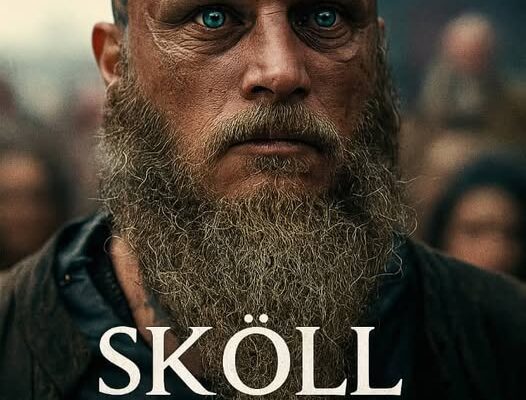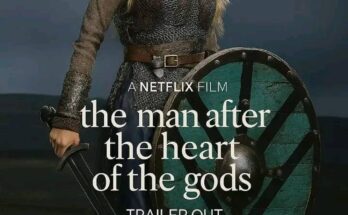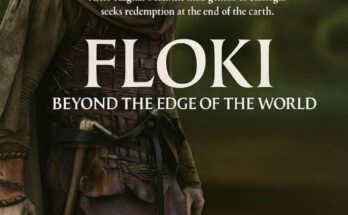The long-awaited Netflix original film Sköll and Odin’s Halls
The announcement of the long-awaited Netflix original film Sköll and Odin’s Halls has sent waves of excitement across the entertainment world, as fans of mythology, epic fantasy, and cinematic storytelling brace themselves for what is being hailed as one of the most ambitious projects the streaming platform has ever undertaken. This film, which has been in development for several years and shrouded in secrecy, promises to merge the grandeur of Norse mythology with Netflix’s signature storytelling style, blending visually stunning battles, powerful character arcs, and themes that speak to timeless human struggles. For those familiar with the legends of Sköll, the mythical wolf that chases the sun, and Odin, the all-father and ruler of Asgard, this project has been anticipated with both curiosity and reverence, as fans hope for a faithful yet innovative reimagining of tales that have shaped Nordic heritage for centuries.
From the outset, the allure of Sköll and Odin’s Halls lies in its source material. Norse mythology has fascinated audiences for centuries, from the sagas passed down orally in Viking culture to the countless adaptations in modern literature, comics, and film. Yet Netflix is positioning this project as something far deeper than just another retelling of old myths. Rather than a standard hero’s journey or a linear fantasy, the film is said to weave multiple storylines, exploring the complex relationship between gods, beasts, and mortals. Sköll, often seen as a symbol of destruction and inevitability, is reimagined not only as a creature of terror but as a being with agency, torn between destiny and desire. Meanwhile, Odin’s Halls—depicted as the golden sanctuaries of Valhalla and the divine realm of the Aesir—serve as the setting for moral conflict, political intrigue, and cosmic stakes that transcend human understanding.
Much of the intrigue surrounding the film has centered on its production scale. Reports suggest that Netflix has spared no expense, committing a budget that rivals some of Hollywood’s biggest blockbusters. Filming has taken place in sweeping landscapes across Iceland, Norway, and Scotland, bringing authenticity to the vistas that will represent Asgard, Midgard, and the other realms of Norse cosmology. Directors, cinematographers, and set designers have all emphasized their goal of creating a film that feels both true to myth and grounded in realism, where gods and monsters coexist in a world that seems tangible. The production has leaned heavily into practical effects, massive handcrafted sets, and real stunts, complemented by state-of-the-art CGI for sequences involving Sköll’s otherworldly pursuit of the sun across the sky.
Character development is at the heart of Sköll and Odin’s Halls, and it is here that Netflix appears determined to distinguish its film from earlier adaptations of Norse lore. Odin himself is not simply the all-knowing, one-eyed patriarch often depicted in myth; instead, he is portrayed as a leader burdened by the weight of his choices, haunted by the cost of maintaining balance between realms, and increasingly aware of his own mortality. His Halls, a symbol of glory and triumph, are depicted with nuance, not just as a paradise for warriors but as a seat of political intrigue where gods debate destiny, power, and justice.
Sköll, traditionally a fearsome wolf destined to devour the sun during Ragnarök, is given particular depth in this retelling. Rather than being a one-dimensional harbinger of doom, Sköll is said to wrestle with themes of freedom, inevitability, and identity. Is he merely a beast carrying out a cosmic script, or does he have the power to change his destiny? This moral ambiguity is expected to form the emotional backbone of the film, making Sköll not simply a monster to be feared but a tragic figure embodying the eternal struggle between fate and choice.
Adding to the anticipation is the casting, which has been kept largely under wraps but is rumored to include a mix of established Hollywood names and rising stars from Scandinavia, bringing authenticity to the portrayal of mythic figures. Netflix has confirmed that the film will be released in multiple languages, with Old Norse phrases incorporated into the dialogue to enhance immersion, while still ensuring accessibility for international audiences. This decision reflects Netflix’s growing commitment to blending global storytelling with cultural authenticity, allowing Sköll and Odin’s Halls to resonate across borders.
Thematically, the film is expected to explore universal questions of mortality, power, loyalty, and sacrifice. By grounding its mythological story in human emotion, the narrative aims to resonate not just with fans of fantasy but with anyone who has wrestled with the tension between destiny and free will. The clash between divine order and chaotic destruction, embodied in Odin’s Halls and Sköll’s relentless chase, serves as a metaphor for the fragility of human life and the cyclical nature of existence. Just as Norse mythology presents Ragnarök not as the end but as a transformation, the film is expected to grapple with the paradox of destruction giving rise to renewal.
For Netflix, Sköll and Odin’s Halls represents more than just another original film—it is a statement of ambition. In recent years, the platform has expanded aggressively into epic storytelling, with successes in projects like The Witcher and Shadow and Bone. Yet this film marks a significant step further, aiming to blend the intimacy of character-driven drama with the spectacle of large-scale fantasy cinema. Insiders suggest that Netflix is treating this not as a one-off release but as the potential cornerstone of a franchise, with possibilities for sequels, spin-offs, and even tie-in series exploring other aspects of Norse mythology. Should it succeed, Sköll and Odin’s Halls could position Netflix as a leader not just in serialized television but in mythological cinema traditionally dominated by Hollywood studios.
Fan expectations are understandably sky-high. Online forums, social media platforms, and fan communities have been buzzing with speculation, dissecting every teaser image and leaked detail. Enthusiasts of Norse mythology are hopeful that the film will strike a balance between honoring traditional sagas and introducing fresh interpretations that keep the story dynamic. Skeptics worry that Hollywood-style dramatization might dilute the raw power of the myths, but early reports suggest the creative team has worked closely with historians, linguists, and cultural consultants to ensure authenticity. This careful blend of respect for tradition and bold artistic vision could prove decisive in winning over both scholars and casual viewers.
In the broader cultural context, the release of Sköll and Odin’s Halls reflects the ongoing fascination with myth and legend in contemporary media. From Marvel’s Thor films to video games like God of War, Norse mythology has enjoyed a renaissance in recent years. Yet unlike those projects, Netflix’s film promises a tone that is less comedic or sensational and more meditative, leaning into the philosophical and spiritual underpinnings of the myths. It is positioned not just as entertainment but as an exploration of themes that have resonated with humanity for centuries—mortality, heroism, and the eternal cycle of life and death.
As the release date approaches, excitement continues to build, with many anticipating that Sköll and Odin’s Halls will become not just a Netflix success but a cultural event. If it lives up to its promise, it could redefine how modern audiences engage with mythological cinema, setting a new standard for both streaming and storytelling. For fans, this is more than just another fantasy film—it is the fulfillment of years of anticipation, a chance to see ancient stories reborn with modern vision, and an invitation to journey once again into the halls of the gods and the heart of legend.



